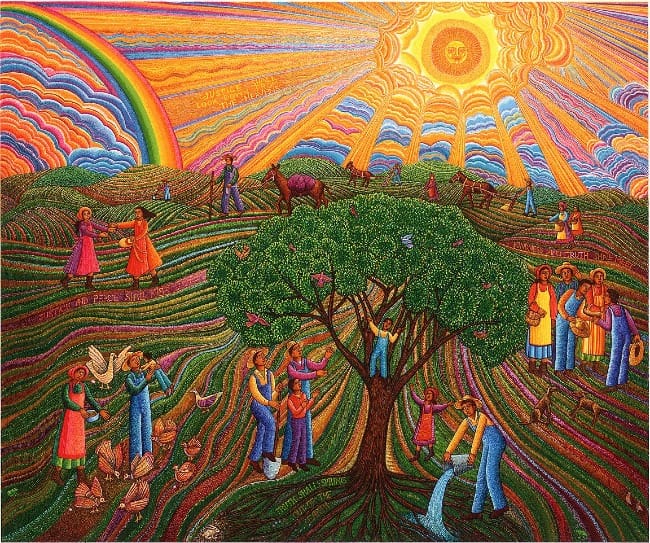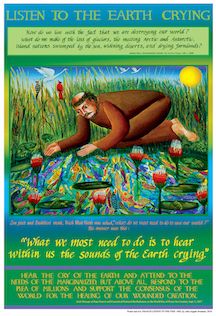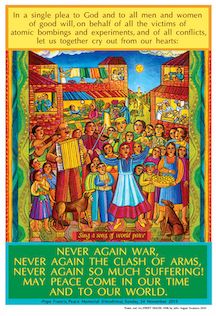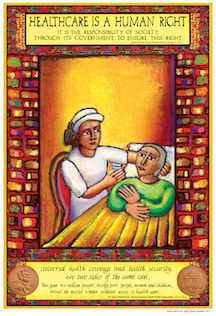True goodness and rightness isn't dull; it shimmers and sings with possibility and joy.

The art of John August Swanson is deeply refreshing. The bright colors and rich textures, lines and patterns immerse you in Swanson's lively and joyful world. This immersion in the optimism that pervades his vision can be like a deep draught of cold water when you are thirsty for hope.
Diversity and abundance are central motifs in Swanson's paintings; there is nothing skimpy about his images. His pictures are full to the brim with life, joy, community, and vision. Bright colors speckled with other bright colors make his work shimmer and shine. His work makes me think of a quilt where varying colors, patterns and textures are skillfully brought together in a way that binds those difference into a cohesive whole. Pieces of his own heritage—his mother was Mexican and his father was Swedish—seem woven together in his art. Elements from each country's folk art are brought into a cohesive whole that delights in bold colors, detailed patterns, stylized shapes, and a strong element of story, creating a distinctive style and vision that is completely his own.
In what could be an ordinary scene, nothing is ordinary. Clouds billow and swirl, layered in vivid colors and waves of light. No clothing is faded; it is vivid, one color layered on top of another on top of another. In his piece illustrating Psalm 85, even the tree trunk is not just plain brown, but brown with ribbons of color running throughout it. The treetop has highlights of red and blue, dotting it like Christmas lights.
Whether it be a lamp, the sun, stars, heaven, light sources are important in Swanson's work, a focal point illuminating the rest of the picture. In Psalm 85, the benevolent orb of the sun shoots out ribbons of light beams in all directions, overseeing and enabling all the life it looks down upon. The words, "It is good" seem to hang in the air like a thought bubble emanating from the sun. And what is it that makes this scene "good"? Many things, but there are four phrases from this psalm embedded physically into the piece, insuring that our attention will be called to these particular words.

Psalm 85
You once favored, LORD, your land, restored the good fortune of Jacob.
You forgave the guilt of your people, pardoned all their sins. Selah
You withdrew all your wrath, turned back your burning anger.
Restore us once more, God our savior; abandon your wrath against us.
Will you be angry with us forever, drag out your anger for all generations?
Please give us life again, that your people may rejoice in you.
Show us, LORD, your love; grant us your salvation.
I will listen for the word of God; surely the LORD will proclaim peace
To his people, to the faithful, to those who trust in him.
Near indeed is salvation for the loyal; prosperity will fill our land.
Love (or kindness) and truth will meet; justice and peace will kiss
Truth will spring from the earth; justice will look down from heaven.
The LORD will surely grant abundance; our land will yield its increase.
Prosperity will march before the Lord, and good fortune will follow behind.
We see community, as exemplified by, “Kindness and truth shall meet,” in many of this picture's images: a flock of birds, a parent lifting a child, two dogs facing each other, a man and his horse working together, birds filling the tree, and just beneath the phrase itself, a group of people meeting each other with warm handshakes and bodies bent toward each other. No one seems entirely alone in the picture; even the single rabbit seems nestled with the tree in his burrow in the roots. People, animals, people and animals, land and people, sun and tree all interact with each other. What is here seems to belong, and that belonging is shown in the glimpses of story the picture shows us. A goose and two chickens have laid eggs in the soil. The people and horses plow the fields. A man digs in the dirt. Everything is connected to something else. This is a cohesive community, woven together in diverse and meaningful ways.
Where do kindness and truth meet in your community?
Justice and peace shall kiss each other. This community has affection and care for each other. In pairs, in groups, people tend the earth, their animals, each other. Two friends move toward each other, arms outstretched, ready to embrace. Arms are opened wide or stretched toward another; no one stands with their arms crossed. There is a strong sense of caring and gentleness in the picture. Even the two frogs seem unafraid as they sit in plain sight.
If you try to picture justice and peace kissing, what do you see?
At the center of the picture is the tree, but before that is the land, laid out in furrowed stripes of color, suggesting an old-fashioned braided rug that everything else grows upon. It seems soft and welcoming, with a suggestion of velveteen. Upon it, people greet each other, do their work, birds peck for seed. The lines of this foundational soil lead to the only plant evident in the picture, the tree whose roots make room for the words, "Truth shall spring out of the earth." In the roots of that tree hides a rabbit; in its crown, several birds perch; to its side, a man, bucket in hand nourishes it with water. People grow crops directly above its crown in the background. Everything in the picture seems to turn and center around that tree. Could the boy standing in the notch of the tree branches be a picture of Christ? His own stance and the posture of those around the tree certainly hint at this possibility. Truth springs up from the earth, portraying that truth is both the source of goodness and the fruit of the goodness in the picture.
What examples of truth have you seen springing up recently?
This community is connected with the sky above it by the beams of sunlight streaming from the sky down to the earth. The sun, shining from the sky, graces the earth with its rays of wavy lines of billowing clouds and colorful light. Looking down, with the words, “Justice will look down from the heavens,” emanating from it, this sun seems pleased with what it sees. Does the justice cause the goodness or respond to it? I would argue both; it is more like a circle than a straight line. The sun (or heavens or God) starts the process of harmony but the earth below and all that are in it are called to nurture that harmony. Actions of kindness, peace and justice help that harmony to grow and spread, which in turns leads back to the sun/heavens/God looking down from the heavens and seeing goodness. In the same way that darkness can spread, light can also spread.
How is justice looking down from heavens a promise to hope in rather than something to dread?
The rainbow in the top right-hand corner is a bulwark against fear, a reminder of God's covenant with all the living creatures of the earth and the hope that gives.
And God said, "Whenever the rainbow appears in the clouds, I will see it and remember the everlasting covenant between God and all living creatures of every kind on the earth." So God said to Noah, "This is the sign of the covenant I have established between me and all life on the earth."
That hope is also a fence protecting the scene in the fields. And how do we get to this scene in the fields? How do we get to this place of justice? Swanson's illustration of Psalm 85 hints at it. It takes work, watering, community, forgiveness, treating all of our neighbors (human and non-human) kindly, treating the earth kindly. Swanson's has created many art posters that present a more overt picture of what is needed for "justice to spring out of the earth."



In his posters he quotes a variety of activists, writers and peacemakers: Pope Francis, Daniel Berrigan, Desmond Tutu, and others calling for justice in immigration policy, creation care, prisons, government spending, peace, health care, care for the elderly, water access for all, to name a few examples. Swanson's deep concern for the world is evident and he isn't blind to the injustice thriving in our world, but he also has hope for wholeness and justice. His art suggests that if we listen to the cries around us, and choose to live as God intends us to live upon this earth and with each other, justice can reign and this world will be better, brighter, more joyful—like his illustration of Psalm 85. His Psalm 85 presents a vision that can fuel us to work for justice and can lend courage, strength, and love to plow the fields and plant the seeds of labor so that all can thrive on this earth that our Creator calls, "very good."
Reflection Question: Is there a specific work for justice you feel called to undertake?
Louise
You can contact me directly at info@circlewood.online.
To see more of the work of John August Swanson, visit his website.
To watch him talk about this piece of artwork, click here.